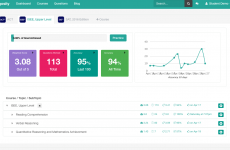 Every minute of every hour each day, we’re sent into sensory overload from a ceaseless stream of updates and notifications about the world around us. As battles rage on in countries near and far, economic downturns and upturns move as swiftly as the wind, and political upheavals constantly change who’s in power, it can be easy for kids to get lost in the fray. Though it may seem like a teacher’s job may be to instruct students on one specific subject, in reality, teachers are entrusted to guide and shape the minds of children to help them make sense of the world and all of its pieces.
Every minute of every hour each day, we’re sent into sensory overload from a ceaseless stream of updates and notifications about the world around us. As battles rage on in countries near and far, economic downturns and upturns move as swiftly as the wind, and political upheavals constantly change who’s in power, it can be easy for kids to get lost in the fray. Though it may seem like a teacher’s job may be to instruct students on one specific subject, in reality, teachers are entrusted to guide and shape the minds of children to help them make sense of the world and all of its pieces.
The outside world will undoubtedly creep into the school halls, whether it be via smartphone or word of mouth. How do we help students understand what’s real and true with a nuanced perspective? The New York Times recently offered up 50 tips for teaching with current events. Here’s a few that might help your student:
Compare News Sources – One of the most important ways to teach a student to understand different perspectives is by presenting students with different perspectives. In college, one of the most fascinating projects that I was assigned involved researching different high-profile subjects and topics of the 1960s, like the Vietnam War and the Civil Rights movement. My classmate and I combed through newspaper archives from more conservative sources, like the Washington Post and the Dallas Morning News, to more centrist sources, like the New York Times and the New York Journal American, to far left and radical sources, like the Rag and the Houston Forward Times. In the end, I had a much better understanding and even agreed at times with the sources that differed dramatically from my own usual point of view. Doing similar activities especially help show high schoolers that they are capable of deciphering a news piece and understanding how different media sources prioritize stories and cover each angle of a story.
Brainstorm Solutions – What if kids ruled the world? It couldn’t hurt to let them try for a day. By offering students the opportunity to stand in place of policy makers, they can weigh options and make decisions that could change lives for the better or worse. Using the Times’ Problem-Solution worksheet, students can work together in groups to draft policy proposals for local and national problems to be presented in class or to local lawmakers.
Scavenger Hunt – Teachers can make their own list of things to find in the news to fit their lesson and have students comb through several sources in timed trials for prizes or bonus points. Alternatively, teachers who are looking to help their students understand how the read the paper more effectively can use the Times’ Scavenger Hunt page to understand how each section of the paper can functions as a part of the whole source.
Write a Rap or a Song – One of our previous articles highlighted ways to make test prep fun. General Academic tutor, Rachel Chung, recommended using funny analogies or stories to help remember facts and vocabulary. Similarly, making songs that incorporate the lesson helps students retain the knowledge by engaging both sides of their brain and encouraging creative expression.
Support Opinions with Facts – One of the most important skills that students should learn is how to formulate an opinion with fact. While there is certain inherent value to having an opinion guided by faith, intuition or observation, teaching students to base their opinions on facts will take them very far in life. Have students practice building this skill by reviewing how other writers from prominent, trust-worthy news sources formulate their opinion pieces.
The difficulties of living in this world certainly don’t make teaching about it any easier. However, by providing students with the tools needed to interpret current events presented by the news media early on, they will develop strong critical thinking skills and will be better equipped to understand and interpret life and the world through a refined lens.















